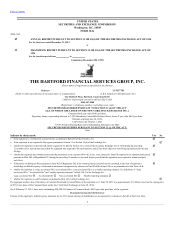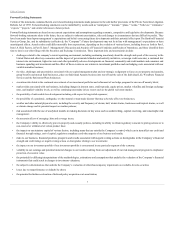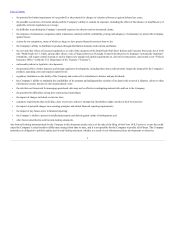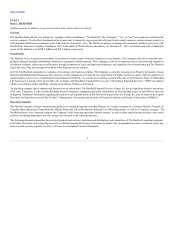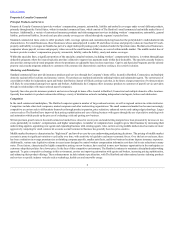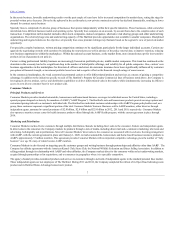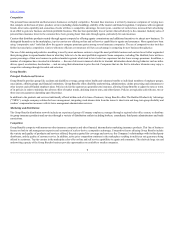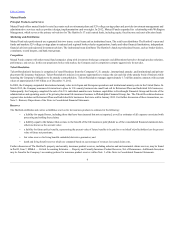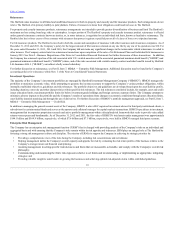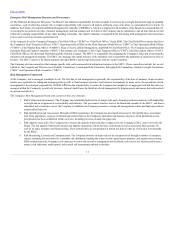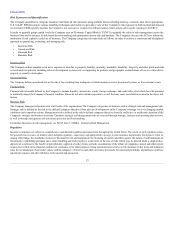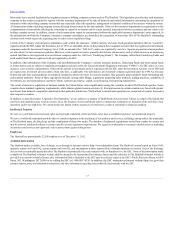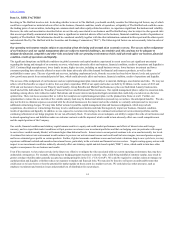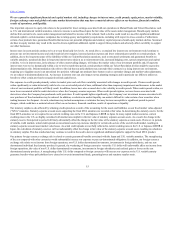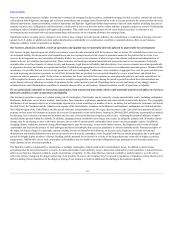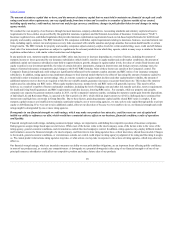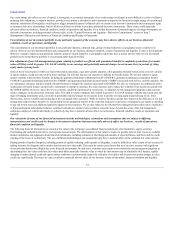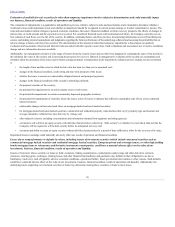The Hartford 2012 Annual Report Download - page 10
Download and view the complete annual report
Please find page 10 of the 2012 The Hartford annual report below. You can navigate through the pages in the report by either clicking on the pages listed below, or by using the keyword search tool below to find specific information within the annual report.
Table of Contents
The Hartford cedes insurance to affiliated and unaffiliated insurers for both its property and casualty and life insurance products. Such arrangements do not
relieve The Hartford of its primary liability to policyholders. Failure of reinsurers to honor their obligations could result in losses to The Hartford.
For property and casualty insurance products, reinsurance arrangements are intended to provide greater diversification of business and limit The Hartford’s
maximum net loss arising from large risks or catastrophes. A major portion of The Hartford’s property and casualty insurance product reinsurance is effected
under general reinsurance contracts known as treaties, or, in some instances, is negotiated on an individual risk basis, known as facultative reinsurance. The
Hartford also has in-force excess of loss contracts with reinsurers that protect it against a specified part or all of a layer of losses over stipulated amounts.
For life insurance products, The Hartford is involved in both the cession and assumption of insurance with other insurance and reinsurance companies. As of
December 31, 2012 and 2011, the Company’s policy for the largest amount of life insurance retained on any one life by any one of its operations was $10. For
the years ended December 31, 2012, 2011 and 2010, the Company did not make any significant changes in the terms under which reinsurance is ceded to
other insurers. The Company entered into two reinsurance transactions upon completion of the sales of its Retirement Plans and Individual Life businesses in
January 2013. See Note 2 - Business Dispositions of the Notes to Consolidated Financial Statements for further discussion of these transactions. In addition,
the Company has reinsured a portion of the risk associated with U.S. variable annuities and the associated guaranteed minimum death benefit (“GMDB”) and
guaranteed minimum withdrawal benefit (“GMWB”) riders, and of the risks associated with variable annuity contract and rider benefits issued by Hartford
Life Insurance K.K.'s (“HLIKK”), an indirect wholly owned subsidiary.
For further discussion on reinsurance, see Part II, Item 7, MD&A — Enterprise Risk Management. Additional discussion may be found in the Company’s
accounting policies for reinsurance within Note 1 of the Notes to Consolidated Financial Statements.
The majority of the Company’s investment portfolios are managed by Hartford Investment Management Company (“HIMCO”). HIMCO manages the
portfolios to maximize economic value, while attempting to generate the income necessary to support the Company’s various product obligations, within
internally established objectives, guidelines and risk tolerances. The portfolio objectives and guidelines are developed based upon the asset/liability profile,
including duration, convexity and other characteristics within specified risk tolerances. The risk tolerances considered include, for example, asset and credit
issuer allocation limits, maximum portfolio limits for below investment grade holdings and foreign currency exposure limits. The Company attempts to
minimize adverse impacts to the portfolio and the Company’s results of operations from changes in economic conditions through asset allocation limits,
asset/liability duration matching and through the use of derivatives. For further discussion of HIMCO’s portfolio management approach, see Part II, Item 7,
MD&A — Enterprise Risk Management — Credit Risk.
In addition to managing the general account assets of the Company, HIMCO is also a SEC registered investment adviser for third party institutional clients, a
sub-advisor for certain mutual funds and serves as the sponsor and collateral manager for capital markets transactions. HIMCO specializes in investment
management that incorporates proprietary research and active portfolio management within a disciplined risk framework that seeks to provide value added
returns versus peers and benchmarks. As of December 31, 2012 and 2011, the fair value of HIMCO’s total assets under management was approximately
$144.1 billion and $164.9 billion, respectively, of which $7.6 billion and $7.1 billion, respectively, were held in HIMCO managed third party accounts.
The Company has an enterprise risk management function (“ERM”) that is charged with providing analysis of the Company's risks on an individual and
aggregated basis and with ensuring that the Company's risks remain within its risk appetite and tolerances. ERM plays an integral role at The Hartford by
fostering a strong risk management culture and discipline. The mission of ERM is to support the Company in achieving its strategic priorities by:
•Providing a comprehensive view of the risks facing the Company, including risk concentrations and correlations;
•Helping management define the Company's overall capacity and appetite for risk by evaluating the risk return profile of the business relative to the
Company's strategic intent and financial underpinning;
•Assisting management in setting specific risk tolerances and limits that are measurable, actionable, and comply with the Company's overall risk
philosophy;
•Communicating and monitoring the firm's risk exposures relative to set limits and recommending, or implementing as appropriate, mitigating
strategies; and
•Providing valuable insight to assist leaders in growing the businesses and achieving optimal risk-adjusted returns within established guidelines.
10

